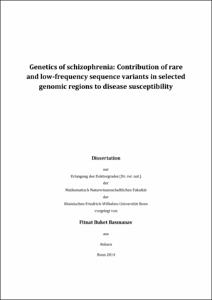Basmanav, Fitnat Buket: Genetics of schizophrenia: Contribution of rare and low-frequency sequence variants in selected genomic regions to disease susceptibility. - Bonn, 2015. - Dissertation, Rheinische Friedrich-Wilhelms-Universität Bonn.
Online-Ausgabe in bonndoc: https://nbn-resolving.org/urn:nbn:de:hbz:5n-39333
Online-Ausgabe in bonndoc: https://nbn-resolving.org/urn:nbn:de:hbz:5n-39333
@phdthesis{handle:20.500.11811/6431,
urn: https://nbn-resolving.org/urn:nbn:de:hbz:5n-39333,
author = {{Fitnat Buket Basmanav}},
title = {Genetics of schizophrenia: Contribution of rare and low-frequency sequence variants in selected genomic regions to disease susceptibility},
school = {Rheinische Friedrich-Wilhelms-Universität Bonn},
year = 2015,
month = mar,
note = {Schizophrenia is a highly heritable, multifactorial mental disorder. Up to date, a number of common SNPs with low penetrance and large rare structural variants (CNVs) with higher penetrance have been identified to contribute to schizophrenia susceptibility. The risk variants identified so far explain only part of the observed heritability, suggesting that many susceptibility variants, both common and rare, still await identification. Aim of the present doctoral thesis was to contribute to the understanding of the genetic basis of schizophrenia by identifying more of these unknown susceptibility variants, in particular rare and low-frequency variants. To reach this aim, three genetic loci which had previously been identified through either genome-wide association studies (GWASs) or CNV studies were resequenced with the underlying rationale that different types of genetic variations can contribute to disease susceptibility at an individual locus. Among the three regions studied were two regions that had emerged from CNV studies, the NRXN1 gene and the 1q21.1 microdeletion region, and one region that had emerged from GWASs, the TCF4 gene. In all of the three regions, discovery samples comprised of about 190 individuals and follow-up samples ranging from about 2500 to 9000 individuals were used. Discovery samples were resequenced for the region of interest to discover rare and low-frequency variants and follow-up samples were used for genotyping of the identified variants. Various statistical tests were performed to test for the association of rare and low-frequency variants in each of these regions with schizophrenia. Complementary analyses like expression and splice site analyses were performed when applicable.},
url = {https://hdl.handle.net/20.500.11811/6431}
}
urn: https://nbn-resolving.org/urn:nbn:de:hbz:5n-39333,
author = {{Fitnat Buket Basmanav}},
title = {Genetics of schizophrenia: Contribution of rare and low-frequency sequence variants in selected genomic regions to disease susceptibility},
school = {Rheinische Friedrich-Wilhelms-Universität Bonn},
year = 2015,
month = mar,
note = {Schizophrenia is a highly heritable, multifactorial mental disorder. Up to date, a number of common SNPs with low penetrance and large rare structural variants (CNVs) with higher penetrance have been identified to contribute to schizophrenia susceptibility. The risk variants identified so far explain only part of the observed heritability, suggesting that many susceptibility variants, both common and rare, still await identification. Aim of the present doctoral thesis was to contribute to the understanding of the genetic basis of schizophrenia by identifying more of these unknown susceptibility variants, in particular rare and low-frequency variants. To reach this aim, three genetic loci which had previously been identified through either genome-wide association studies (GWASs) or CNV studies were resequenced with the underlying rationale that different types of genetic variations can contribute to disease susceptibility at an individual locus. Among the three regions studied were two regions that had emerged from CNV studies, the NRXN1 gene and the 1q21.1 microdeletion region, and one region that had emerged from GWASs, the TCF4 gene. In all of the three regions, discovery samples comprised of about 190 individuals and follow-up samples ranging from about 2500 to 9000 individuals were used. Discovery samples were resequenced for the region of interest to discover rare and low-frequency variants and follow-up samples were used for genotyping of the identified variants. Various statistical tests were performed to test for the association of rare and low-frequency variants in each of these regions with schizophrenia. Complementary analyses like expression and splice site analyses were performed when applicable.},
url = {https://hdl.handle.net/20.500.11811/6431}
}






